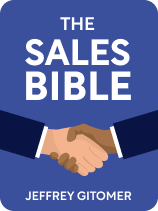

This article is an excerpt from the Shortform book guide to "The Sales Bible" by Jeffrey Gitomer. Shortform has the world's best summaries and analyses of books you should be reading.
Like this article? Sign up for a free trial here .
What sales wisdom does Jeffrey Gitomer have to share from his vast experience? Why does he regard selling as a science rather than an art?
Jeffrey Gitomer has 40 years of experience in sales. He believes that anyone can learn to sell, and he shares his insights and solutions in the book The Sales Bible. While he doesn’t go into depth about any particular methodology, he offers plenty of practical tips for everyday selling scenarios.
Keep reading for The Sales Bible review.
The Sales Bible Review
This The Sales Bible review introduces you to the bestselling classic. The book is Jeffrey Gitomer’s collection of sales strategies gathered from his 40 years of experience in the field. To Gitomer, selling is a science and a discipline, not an art—it’s a learnable, repeatable process that you follow to move another person to make a purchase. He writes that there are thousands of ways to sell and that you can choose the method that suits you best; however, your personal method should be grounded in a positive attitude, solid product knowledge, and excellent customer service.
(Shortform note: Gitomer says that anyone can learn to sell, but if you’re not technically in the field of sales, you may not think his advice applies to you. However, Daniel Pink, who writes about the intersection between business, creativity, and behavior, argues that everyone is selling something, so it’s important to learn how to do it. In To Sell Is Human, Pink writes that people spend 40 percent of their time at work in contemporary selling—influencing or convincing others to give up an intangible resource—so the skill is critical for professional success, regardless of your field.)
Gitomer began writing the first edition of The Sales Bible in 1993 and has since updated it to reflect changes in the selling landscape. (Shortform’s guide is based on his 2010 updated version.) He describes the contents of the book not as a system, but as practical strategies and solutions to common selling problems. He emphasizes that the first step is to have a positive attitude or you’ll never be successful. From there, he offers detailed tips for various parts of the selling process: setting goals, making the best impression, building and maintaining relationships, learning to listen, and closing the sale.
| Beyond Principles: Specific Selling Methods Gitomer offers plenty of practical tips for everyday selling scenarios, but he doesn’t go in depth into a specific selling methodology. Some of the more popular selling methods you can explore are: The Five-Step Selling Process: In Sell or Be Sold, Grant Cardone outlines the five universal steps of selling: 1) Greet the customer, 2) figure out what the customer wants and needs, 3) present a product, 4) make an offer, and 5) close. SPIN Selling: This methodology makes use of a questioning method summarized by the acronym SPIN: Situation, Problem, Implications, and Need-Payoff. The book SPIN Selling details how to apply this method. The Straight Line Method: Popularized by sales trainer Jordan Belfort in Way of the Wolf, this method has four basic steps: 1) Take control of the sale immediately, 2) build rapport by asking questions, 3) obtain information, and 4) make a sales presentation. |

———End of Preview———
Like what you just read? Read the rest of the world's best book summary and analysis of Jeffrey Gitomer's "The Sales Bible" at Shortform .
Here's what you'll find in our full The Sales Bible summary :
- How to become a non-salesperson salesperson
- How to make the best impression within the first 30 seconds
- Methods for closing the sale without being pushy






